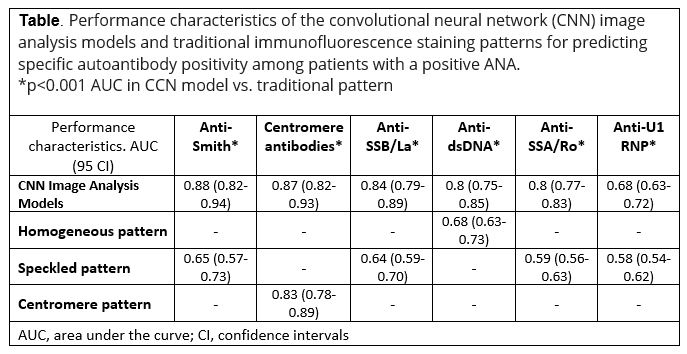Session Information
Date: Sunday, November 12, 2023
Title: Abstracts: SLE – Diagnosis, Manifestations, & Outcomes I: Biomarkers
Session Type: Abstract Session
Session Time: 4:00PM-5:30PM
Background/Purpose: Antinuclear antibodies (ANA) are key biomarkers in the diagnostic evaluation of systemic autoimmune diseases and are widely used in clinical practice. The most accepted ANA screening is ANA by immunofluorescence (IFA) on HEp-2 cells, which allows the detection of antibody binding to specific intracellular targets, resulting in diverse staining patterns. While a HEp-2 IFA pattern(s) can guide confirmatory testing and may be useful for elucidating a specific clinical diagnosis or prognosis, pattern recognition is observer-dependent and subjective. We tested the hypothesis that applying artificial intelligence (AI) to Hep2 IFA could identify specific autoantibodies associated with systemic autoimmune diseases.
Methods: Using paired ANA by Hep-2 images and autoantibody testing data, we trained a convolutional neural network (CNN) to identify patients with positivity for anti-dsDNA, Smith, U1RNP (recombinant human antigens for RNP68 or RNPA), SS-A/Ro (combined for Ro52 and ro60), SS-B/La, and Centromere B antibodies. We included patients with at least one digital image of an ANA by Hep-2 between 12-12-2016 and 6-2-2022 who also were tested for the indicated autoantibodies ≤ 90 days of the ANA by Hep2. If a patient had multiple ANA by Hep2, only the first result was included. We allocated the positive ANA images (those with a titer of ≥ 1:80) to the training, internal validation, and testing datasets on an 80:10:10 ratio. The validation dataset was used to monitor the training process for each autoantibody model. The performance of each model was then evaluated in a separate holdout testing data set by performing receiver operator characteristic analysis to determine the area under the curve from (AUC). For reference, the predictive performance of each image analysis model was compared to the IFA staining patterns classically associated with each respective autoantibody.
Results: In total, 410,075 patients tested for ANA by HEp-2 IFA were included in the dataset. Of these, 136,156 had a positive ANA, and 47,093 also had specific autoantibody serology testing within 90 (mean age = 55.0 ± 17.7 years, % female = 78.6%). The results are detailed in the table. All models, except anti-RNP, had an AUC ≥ 0.80. The CNN image models had a superior predictive performance in all cases than the traditional staining patterns (P < 0.001), except centromere antibody, where the performance was similar (P=0.135).
Conclusion: The application of AI to the widely used ANA by HEp-2 IFA permits the identification of specific autoantibody detection without relying on stain patterns. This model requires further refinement and external validation. However, it holds promise as a revolutionary way to screen for autoantibodies, eliminating concerns about technical staff expertise and interrater reliability, increasing access to care, information obtained from the ANA by HEp-2 IFA, and decreasing costs.
To cite this abstract in AMA style:
Vanderboom P, Dasari S, Tebo A, Snyder M, Duarte-Garcia A. Screening for Specific Antinuclear Antibodies Using an Artificial Intelligence-enabled Antinuclear Antibody HEp-2 Substrate by Indirect Immunofluorescence Assay [abstract]. Arthritis Rheumatol. 2023; 75 (suppl 9). https://acrabstracts.org/abstract/screening-for-specific-antinuclear-antibodies-using-an-artificial-intelligence-enabled-antinuclear-antibody-hep-2-substrate-by-indirect-immunofluorescence-assay/. Accessed .« Back to ACR Convergence 2023
ACR Meeting Abstracts - https://acrabstracts.org/abstract/screening-for-specific-antinuclear-antibodies-using-an-artificial-intelligence-enabled-antinuclear-antibody-hep-2-substrate-by-indirect-immunofluorescence-assay/

